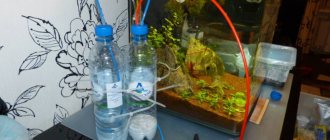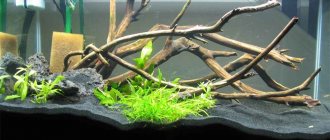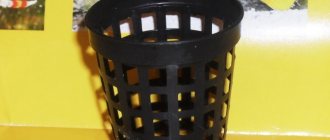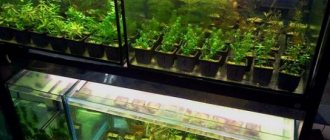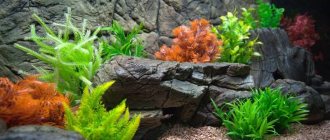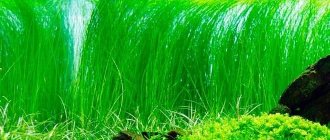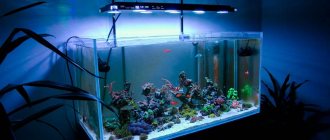Today, more and more often, aquarium lovers prefer natural, living greenery to artificial greenery. Aquarium plants give your home pond the appearance of a natural ecosystem or an exotic underwater landscape that imitates a garden, lawn, or sunken ruins of a city. But in an aquarium, the role of hydrophytes is not limited to just an aesthetic function.
The benefits of aquarium plants
Higher aquatic plants are important producers and form the autotrophic block of the hydroecosystem.
They:
- release oxygen into the environment, which is necessary for the respiration of fish and other aquatic organisms;
- absorb carbon dioxide;
- change the composition of water and its physical and chemical characteristics;
- synthesize organic substances;
- provide food and shelter for ichthyofauna and aquatic invertebrates;
- change the mode of movement of water flows created by the aquarium equipment;
- absorb, accumulate and neutralize certain types of pollutants (pollutants) and xenobiotics (substances toxic to living organisms).
Thus, plants play the following role in the aquarium:
- filtering;
- absorption;
- storing;
- detoxification;
- oxidative.
In addition, most of the vegetation performs a sanitary function, inhibiting the development and reproduction of bacteria, some pathogens of infectious diseases of fish, crustaceans and aquatic invertebrates.
Among the representatives of aquatic flora there are plants that have bioindicator properties. Based on their condition, the aquarist will quickly notice changes in the chemical composition of the water and correct them in a timely manner.
Carbon dioxide
Carbon dioxide is needed by plants for photosynthesis, so it is an important component for their normal development.
Carbon dioxide appears in the aquarium naturally (fish respiration), as well as with the help of special carbon dioxide supply systems. The use of this system is advisable if there are few fish in the aquarium. If there are enough of them, then in most cases they release the required amount of carbon dioxide.
Features of maintenance and care
Each group of flora requires special care. If the plantings are not thinned out, fast-growing hydrophytes fill the entire space of the aquarium, displacing other plants and fish. Others grow slowly, resting in winter.
In addition, there are types of hydrophytes:
- growing in soft, neutral or slightly acidic water;
- adapted to fresh water with a high content of calcium carbonate;
- needing salty sea water.
Some plants are light-loving, others prefer shade. It is important to comply with the requirements for environmental temperature, take into account the density of plantings and the type of fish that will live in the home pond.
The most popular plants among aquarists do not require strict adherence to chemical composition and feel good in a wide temperature range. Others require specific conditions to be maintained.
Filtration
In any aquarium, the use of a filtration system is mandatory and often an aquarium filter is sold complete with the aquarium. Basic filtration requirements for keeping live plants in an aquarium:
- the filter should not create excessive water movement and aeration, due to which precious carbon may be lost;
- the filter should remove excess particles in the water that may interfere with lighting or settle on plant leaves;
- the filter should create a flow through which nutrients will be distributed evenly throughout the container.
Due to all of the above, bottom filters are not the best choice.
What is necessary for the life support of plants in an aquarium?
For plants in a home pond you need:
- substrate (for rooting);
- water of suitable temperature and composition;
- light - artificial or natural;
- fertilizers
Some hydrobionts require aeration or heating of the soil. To ensure the necessary chemical characteristics of water, compounds are added to it that soften it or make it harder. Calcium bicarbonate is used to maintain temporary hardness; calcium and magnesium are used to maintain permanent hardness.
Today it has become popular to equip aquariums with CO² supply systems. With a lack of gas, the leaf becomes covered with a whitish coating of salt deposits, and the plant itself lacks CO² for normal vegetation.
Marsh plants suffer the most from unaesthetic crust: elodea, anubias, hornworts. They have learned to extract the necessary gas from bicarbonates, but a side effect of the process is a build-up of salt.
The level of carbon dioxide depends on the volume of water, its hardness, and the density of plantings. For a 500 liter capacity you need 10-12 liters of gas.
To bind and hold CO² at the required level, it is necessary that the water hardness is ≥2° dKH.
It is important to control the water-alkaline balance (pH). Most plants develop in the range of 6.8-7.4.
By changing the water weekly, you can maintain pH and hardness at the proper level. If it is necessary to acidify the medium, add peat.
Some novice aquarists forget that flow is necessary for normal growth of flora.
It evens out the temperature, displaces excess CO², and removes plaque and fish waste products.
Plants with delicate small leaves, mosses, and ferns are especially sensitive to plaque.
Disadvantages of aquascaping
When populating a tank with living things, including plants, there is always a risk of disease and waste. The good news is that the disease is rare in water gardens. Waste can be managed through careful monitoring. Remove loose or discarded leaves and dead plants as soon as you spot them. Here are some of the most common plant problems.
- Yellow leaves: Iron deficiency, which can be corrected with an iron-containing fertilizer for aquatic plants (never use fertilizers intended for land plants, they will harm your fish)
- Dark leaves: too much iron, usually solved by changing the water
- Holes: Fish gnawing or rot caused by high nitrate levels, corrected by changing the water.
- Only some plants die: too little CO2 for dying species; corrected by learning the correct levels needed for each plant in your tank (watch your pH; adding more CO2 lowers it)
Another disadvantage is working with fish products. Most medications are not herbal, which means you will have to take your pets to a hospital tank for treatment. The same goes for any tonic, additive, or additive intended for fish. You will need to make sure that they are suitable for your aquascape tank.
Methods of propagation and planting
Plant the plants in an aquarium that is not yet filled with water. Before this, they are disinfected in a solution of potassium permanganate and examined. Damaged leaf blades are removed, and long roots are shortened.
If the plants are taken from a natural body of water, they must undergo a 15-day quarantine before the fish are added to the aquarium. The temperature is maintained at +24…+26°С. This way the parasites leave the cysts faster and can be destroyed.
Rooting plants are planted in separate holes or special pots filled with peat and clay. It is necessary to ensure that the soil does not cover the growing points, and that the roots fit freely into the holes without breaking.
There are no rules for the location of plants, but it is more logical to place tall and large ones along the back and side walls, leaving space for fish and a better view, and low-growing and ground cover plants - in the foreground.
Mosses and floating plants are fixed on decorative bottom elements using a mesh or fishing line.
Brightly colored plants form separate groups. Against a green background, bush plantings of red and yellow flowers form bright spots.
Most hydrobionts reproduce vegetatively - by shoots or layering.
They need to be planted and rooted in a timely manner. To prevent bottom dwellers from undermining the plantings, the soil around the roots is reinforced with pebbles. Plants are regularly fed.
Pet stores sell special tablets that stimulate growth processes and replenish the substrate with useful substances.
Pour in water and let it sit
Water for aquarium.
If tap water is used, it is aged to remove chlorine. Pour gradually onto a saucer placed at the bottom so that the soil does not erode. Fill the container completely and turn on the equipment.
Check the operation of the filter and temperature conditions. The filter and compressor must not be switched off. When there is a lack of oxygen, the water is colonized by anaerobic bacteria, and their activity produces a putrid odor. After a few weeks, a biological filter of beneficial bacteria forms in the aquarium.
At first, the water may become cloudy from ground dust that rises up. In a maximum of a week it will filter out. Whitish turbidity is also harmless. It is a consequence of active biological processes. In a few days, the water will become clear - the microorganisms have normalized the internal biosystem, and you can introduce fish. The biological environment is completely formed over the course of a month.
What fertilizers to use
Fertilizers are used for feeding:
- liquid;
- solid.
Liquids are applied directly into the water, and solids are added under the root system into the soil. There are special calculators that allow you to calculate the rate and frequency of product application. Experts advise introducing fertilizers during the day, because energy is needed to absorb nutrients, and it is produced in plants under the influence of light.
Tips for caring for a new aquarium
To create conditions for a full life for the inhabitants, it is important to adhere to the rules for caring for a new aquarium during the first month:
- They do not carry out any cleaning or water replacement.
- Green algae can be a nuisance. At this time, they are removed only mechanically - scraped off the walls.
- They do not use fertilizers - those that are in the soil and added when planting are enough. Algae can take advantage of excess nutrients.
- The duration of illumination is increased gradually: from 5 hours in the first 7 days to 12. Each week, 1 hour is added.
- Monitor the temperature. The norm for most inhabitants is +24…+25°С.
- Feed once a day. They give such an amount of food that it is eaten in 5 minutes. Fish are constantly looking for food, but this does not mean that they are hungry.
Following these simple rules will help you avoid mistakes and restarting the aquarium.
Bookmarks 0
Compatibility of aquarium plants
The incompatibility of different plants is due only to the difference in comfortable growing conditions. Representatives of flora that are demanding of lighting and water hardness will not coexist in one container.
For example, antagonists are Vallisneria and Cryptocoryne. The first is unpretentious and undemanding to the pH of the water; it can grow well in the conditions in which the second lives, but in terms of light levels they are diametrically opposed.
Cryptocoryne needs a lot of light, and with high insolation, Vallisneria grows poorly and may even die due to algae fouling on the leaves. In addition, Cryptocorynes needs iron, but Vallisneria does not like it. And these plants differ in CO² content.
Therefore, the choice of plants for joint planting should be based on knowledge of favorable conditions for different hydrophytes.
Light.
Expensive and good is better than bad and cheap. Anyone who says otherwise is probably just joking. It is best to use special lamps for herbal aquariums. But almost any lamp will be suitable for starting our exercises; replacing it with something more serious will happen later. Or it won't happen. A very important device in my opinion is the on and off timer. It is very inexpensive, but it perfectly evens out the daily cycles in the aquarium. There is no need to shine for a long time; for most species, 9 hours is enough. It should be remembered that it is excessively long, and not excessively bright, daylight hours that are one of the main reasons for the appearance of green algae.
Common diseases
Most hydrobionts are sensitive indicators of environmental conditions. Lack of lighting, macro- and microelements, and temperature fluctuations affect the appearance and growth of plants.
Main symptoms
Symptoms that require immediate correction of living conditions:
- yellowing - deficiency of iron, phosphates;
- lightening of the plate and darkening of the veins - lack of magnesium;
- the appearance of holes with a yellow edge - lack of potassium;
- plate grinding - low temperature;
- decreased growth rate - lack of CO²;
- spoilage of roots - caked, compacted substrate;
- thin, weak, pale stems - lack of light;
- stunted, weak plates - stagnant water.
If algae growth appears on the leaves, it may be due to too much light.
Treatment options
Depending on the cause of the disease, treatment is prescribed.
First of all, you need to compensate for the damaging factor: add the necessary micro- and macroelements, increase/decrease lighting, and change the water.
If the plant continues to hurt, you should continue the diagnosis and find out the cause.
Aquarium plants for beginners
Rare, demanding plants require proper care, which is impossible without experience and knowledge.
For beginners, you can choose unpretentious, easy to care for, but no less beautiful species. Below is a brief overview of such hydrophytes - their names and a description of their characteristic features.
Artificial carpet
The most popular is the so-called.
“artificial carpet” made up of various dummies. They decorate the bottom of the aquarium. It is especially good if you have bottom filters. This “carpet” does not require cutting, like natural ground cover plants.
It is not suitable if there are fish in the tank that actively dig the soil.
Duckweed
Most often, duckweed and trilobed duckweed are used in aquariums. These are plants floating on the surface of the water with small leaves and weak roots. They multiply quickly, so they require regular thinning.
Duckweed does not require compliance with the chemical characteristics of water; it grows in a wide temperature range (+12…+30°C). The only prerequisite is good lighting.
Hygrophiles
A large species, including various hydrophytes and breeding forms. Most require nutritious soil, long-lasting and bright light. Hygrophila loosestrife has long, narrow, bright green leaves. This herb grows from a basal rosette to form a beautiful green background.
Hygrophila araguaia has lilac-colored leaf blades and grows on short stems. Hygrophiles Schisandra and Rosanerviga have an unusual yellow color and large leaves with convex veins. The conditions are also somewhat different, since the habitats of hygrophila are different.
Hornwort
The most popular plant among beginners.
The Christmas tree-like branches are a good mechanical filter - they collect all the garbage: organic matter, food residues and waste products of hydrofauna. In addition, the plant purifies water from nitrates. It is undemanding in terms of temperature and lighting, and is available (available in every pet store and in any market).
Hornwort does not have roots, but has rhizoids with which it clings to any protrusions or soil. It can be planted in separate groups, secured with fishing line or netting, or left to float in the water column.
Vallisneria
Another narrow-leaved species of aquatic vegetation. It has many shapes (including spiral-shaped), differing in width, leaf color, and type of venation.
Fish do not bite the strong ribbons of Vallisneria, but they can undermine the root if it is poorly rooted.
Long leaves reach the surface and form a beautiful frame.
If there are few bushes, there is no need to trim them: you can plant them near filters, along the walls, or form green islands.
Riccia floating island
A species of liver moss. Riccia does not have leaf blades, stems, or roots, and is represented by a flat branching thallus.
It forms beautiful green islands at the surface of the water and requires bright lighting and heat (+22...+26°C).
Under unfavorable conditions, it breaks up into fragments, and the lower part of the lumps rots.
Cryptocoryne Wendt
It has a well-developed creeping rhizome with rosettes.
The leaves are large, wide, brown or olive in color.
Loves shade. The more space, the more beautiful the plant, so it is planted in separate bushes in the central part of the aquarium.
Fern
There are a large number of species that grow in water.
But the most popular are ferns:
Azolla
Indian
Congolese
Thai
The most unpretentious is the Indian fern. It has long, feathery leaves that are a nice light green or emerald color that look good in the foreground of a panorama. The plant can withstand temperature fluctuations, but under conditions below +25°C its growth slows down.
Lighting
Plants need about eight hours of light daily. However, some prefer low light (see list of types below). You can set your aquarium lighting timer to keep the clock regular each day, and if your tank contains both low-light plants and high-light plants, simply landscape them so that the low-light species sits in the shadow of the other.
Brightness is measured per gallon.
- Low: 1 to 2 Watts (per gallon)
- Medium: 2 to 3 W
- Brightness: 3 to 5 W
- Very bright: 5 watts or more
What is the difference between plants and algae
Algae appeared on Earth long before higher plants, and therefore have a more primitive structure. Their body (thallus, thallus) is not differentiated into organs (stem, leaves, roots) and tissues.
They reproduce in 3 ways:
- asexual;
- sexual;
- vegetative.
Algae can be unicellular, multicellular and colonial, and plants can only be of the first and second types. Most algae live in water, while the bulk of plants live on land and only a small part live in water or at the boundaries of environments.
Water
First, you should find out exactly what water requirements the plants you are planning to plant have. Most of them can grow in water with the following indicators: pH – 6.5-7.2, hardness – 4-12 dH.
It is important to note that in some regions of Russia, an obscure, cloudy liquid flows from the tap, which, of course, cannot be used for an aquarium without preliminary cleaning. A reverse osmosis filter is suitable for this.


